Router stats
midar-iffinder-kapar dataset: 32,604,620 routers total.
midar-iffinder dataset: 33,303,031 routers total.
We classify routers into the following types:
1) The router has some identified interfaces ("I' router).
2) The router does not have any identified interfaces ("U" router).
midar-iffinder-kapar dataset: 9,078,230 (28%) of routers have 0
identified interfaces.
midar-iffinder dataset: 9,380,103 (28.2%) of routers have 0 identified interfaces.
For a high degree router r, we split its degree into the following
components:
1) Number of links from r to I routers due to r's presence in link clouds.
2) Number of links from r to U routers due to r's presence in link clouds.
2) Number of links from r to I routers due to point-to-point links.
3) Number of links from r to U routers due to point-to-point links.
For each router, we then find the maximum degree component, i.e., the component of its degree (from the 4 listed above) that contributes the most to that router's total degree.
| dataset | degree greater than | total | cloud-I | % | cloud-U | % | point_I | % | point-U | % |
|---|---|---|---|---|---|---|---|---|---|---|
| midar-iffinder-kapar | 10000 | 141 | 60 | 42 | 6 | 4.2 | 20 | 14 | 55 | 39 |
| midar-iffinder | 10000 | 178 | 116 | 65.1 | 3 | 1.6 | 17 | 9.5 | 42 | 23.5 |
| midar-iffinder-kapar | 5000 | 386 | 128 | 33 | 17 | 4 | 87 | 22 | 154 | 40 |
| midar-iffinder | 5000 | 423 | 196 | 46.3 | 21 | 4.9 | 69 | 16.3 | 137 | 32.3 |
| midar-iffinder-kapar | 1000 | 2536 | 459 | 13 | 225 | 6.3 | 1852 | 52 | 1007 | 28 |
| midar-iffinder | 1000 | 3976 | 1013 | 25.4 | 240 | 6.0 | 1674 | 42.1 | 1049 | 26.3 |
In all three cases, a significant fraction of the links for high degree routers are due to point-point links to routers that have no identified interfaces. A significant fraction of the high degree router links are due to clouds.
| midar-iffinder-kapar | midar-iffinder |
|---|---|
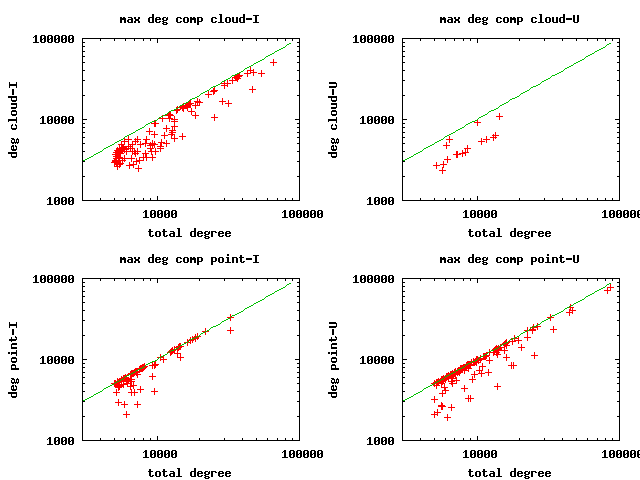
|
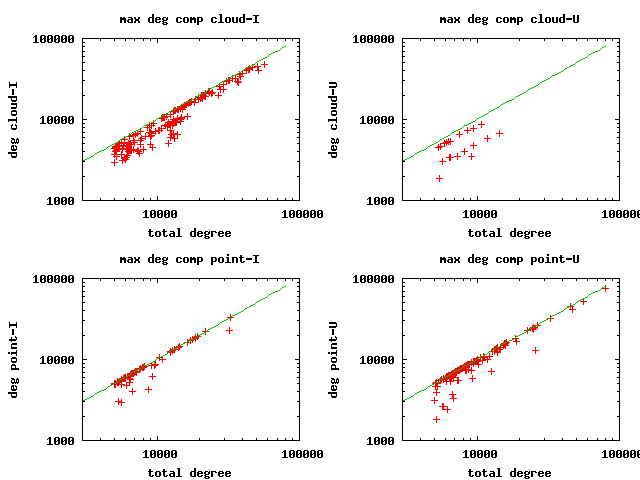
|
For each high degree router, we then determine the contribution of the max-degree component towards the total degree. In particular, we find that when the max degree component for a router is "deg point-U" (meaning that the max number of links of this router are point to point links that connect it with routers that have no identified interface), the correlation with line y=x is strong. This indicates that for such routers, most of their high degree is accounted for by the "deg-point-U" component.
For each high degree router, we determine the set of identified interfaces on that router, and find the AS that is found most frequently on that router. We then count the most frequently appearing AS for routers with degree greater than 10000, 5000 and 1000. We repeat this analysis using both the midar-iffinder-kapar and midar-iffinder datasets.
Degree > 10000
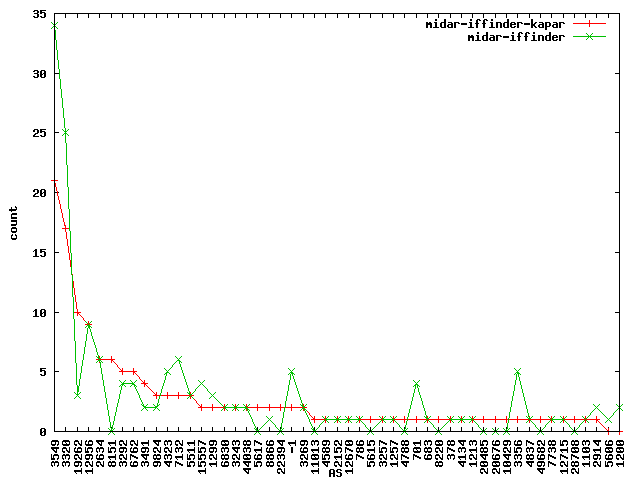
Degree > 5000
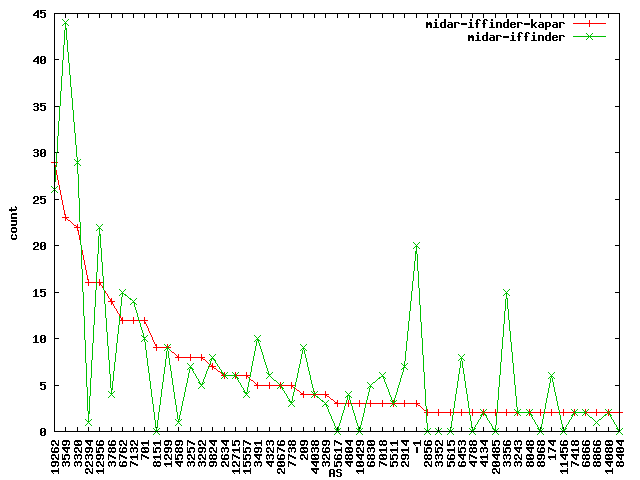
Degree > 1000
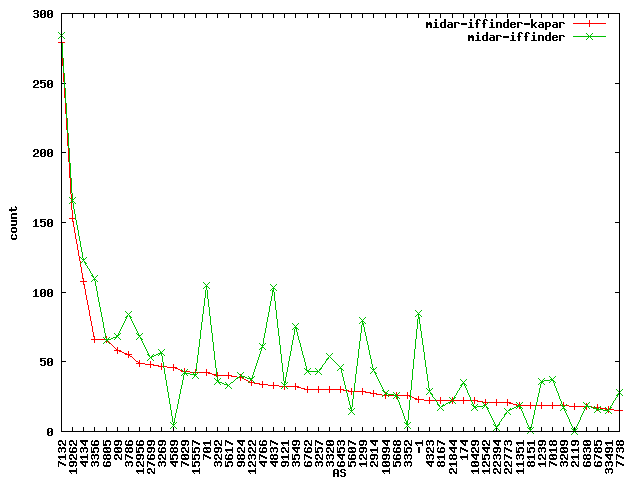
In each of the cases, we find some ASes that appear frequently in the set of interfaces of high degree routers. In particular, Global Crossing (3549) and ATT (7132) appear in this list, and are known to have an MPLS network. In the trace analysis, we study some examples of high degree router that belong to these ASes, and show that they produce signatures in the traces that are typical of MPLS networks.
Link stats
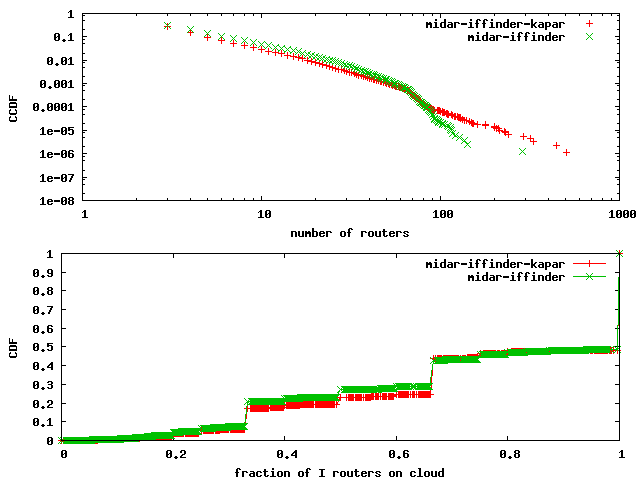
| dataset | total links | invalid (<2 routers) | % | point-point (2 routers) | % | cloud (>2 routers) | % | U-U links | % |
|---|---|---|---|---|---|---|---|---|---|
| midar-iffinder-kapar | 32970780 | 62643 | 0.1 | 32036696 | 97.1 | 871441 | 2.6 | 3521447 | 10.6 |
| midar-iffinder | 33448073 | 64265 | 0.1 | 32568006 | 97.3 | 815802 | 2.4 | 3627330 | 10.8 |
Trace analysis
We look at examples of high degree routers from the midar-iffinder-kapar datasets whose degrees are dominated by each of the 4 degree components mentioned above. We then isolate the traces in which these routers appear and look for possible reasons why these routers became high degree routers. We process the raw traces to the following format for each hop:ip_address:router:AS:[H], where the "H" indicates that this hop belonged to a high degree router
Example 1: Router N28276, max degree component cloud-I (51,326 out of 65,463 links, max. number of interfaces from address space of AS3549)
We find router N28276 in traces of the form:
192.107.171.130:N5200125:681 192.107.171.142:N3383168:681
192.107.171.49:N26950:681 130.217.2.6:N69162:681
203.167.234.85:N98310:4768 218.101.61.193:N242019:4768
203.98.50.1:N260157:9901 203.98.50.251:N30081:9901
203.167.233.10:N780:4768 202.84.142.129:N256215:4637
202.84.251.238:N244216:4637 134.159.62.134:N28276:4637:H
67.17.110.2:N254810:3549:H 64.211.192.74:N423:3549
203.117.34.2:N423:38861 203.117.35.42:N5606672:38861
0.0.0.0:-1:-1 0.0.0.0:-1:-1 0.0.0.0:-1:-1
0.0.0.0:-1:-1 0.0.0.0:-1:-1
The sequence of hops
134.159.62.134:N28276:4637:H
67.17.110.2:N254810:3549:H 64.211.192.74:N423:3549
fits
the signature of an MPLS network. The trace has only 2 hops on 3549's
address space, and the routers containing the first and second hops
appear as high degree routers. AS3549 (Global Crossing) advertises an
MPLS network.
We use this observation to determine a signature for high-degree routers that are created due to MPLS. Let A(R) be the AS that accounts for the majority of interfaces on a router R. We then look at traces in which the router R appears, and count the total number of hops in A(R)'s address space. The conjecture is that if a high-degree router is due to MPLS, then it should have just 2 or 3 hops in A(R)'s address space. We use the threshold of 3 hops in A's address space as the signature of a high-degree router due to MPLS.
The following table shows, for each router which had a maximum degree component of cloud-I, the fraction of traces that matched the MPLS signature defined above.
| Router | Fraction of traces |
|---|---|
| N685 | 0.563194 |
| N724 | 0.794542 |
| N279573 | 0.823812 |
| N273305 | 0.840812 |
| N293780 | 0.881266 |
| N21583 | 0.883481 |
| N121505 | 0.887631 |
| N16220 | 0.900281 |
| N16947 | 0.901151 |
| N251632 | 0.907891 |
| N22638 | 0.912951 |
| N28276 | 0.918381 |
| N279244 | 0.96214 |
| N243740 | 0.97621 |
| N154072 | 0.98064 |
| N9364 | 0.98359 |
| N254810 | 0.9845 |
| N338411 | 0.99022 |
| N298809 | 0.99963 |
Example 2: Router N175098, max degree component point-I (32,551 out of 32,718 links)
205.189.33.78:N5682499:6327_6509 205.189.33.1:N242038:6327_6509 205.189.32.226:N12198:6509 62.40.124.221:N45115:20965:H 62.40.112.138:N5362:20965 62.40.125.126:N5723:20965 193.1.236.2:N75348:1213 193.1.196.225:N175098:1213:H 87.46.227.207:N19069783:1213
205.189.33.78:N5682499:6327_6509 205.189.33.1:N242038:6327_6509 205.189.32.226:N12198:6509 62.40.124.221:N45115:20965:H 62.40.112.138:N5362:20965 62.40.125.126:N5723:20965 193.1.236.2:N75348:1213 193.1.196.225:N175098:1213:H 87.47.37.189:N19071887:1213
205.189.33.78:N5682499:6327_6509 205.189.33.1:N242038:6327_6509 205.189.32.226:N12198:6509 62.40.124.221:N45115:20965:H 62.40.112.138:N5362:20965 62.40.125.126:N5723:20965 193.1.236.2:N75348:1213 193.1.196.225:N175098:1213:H 87.47.31.136:N19071701:1213
205.189.33.78:N5682499:6327_6509 205.189.33.1:N242038:6327_6509 205.189.32.226:N12198:6509 62.40.124.221:N45115:20965:H 62.40.112.138:N5362:20965 62.40.125.126:N5723:20965 193.1.236.2:N75348:1213 193.1.196.225:N175098:1213:H 87.46.21.2:N19063210:1213
205.189.33.78:N5682499:6327_6509 205.189.33.1:N242038:6327_6509 205.189.32.226:N12198:6509 62.40.124.221:N45115:20965:H 62.40.112.138:N5362:20965 62.40.125.126:N5723:20965 193.1.236.2:N75348:1213 193.1.196.225:N175098:1213:H 87.46.5.92:N19062718:1213
205.189.33.78:N5682499:6327_6509 205.189.33.1:N242038:6327_6509 205.189.32.226:N12198:6509 62.40.124.221:N45115:20965:H 62.40.112.138:N5362:20965 62.40.125.126:N5723:20965 193.1.236.2:N75348:1213 193.1.196.225:N175098:1213:H 87.45.205.16:N19060945:1213
205.189.33.78:N5682499:6327_6509 205.189.33.1:N242038:6327_6509 205.189.32.226:N12198:6509 62.40.124.221:N45115:20965:H 62.40.112.138:N5362:20965 62.40.125.126:N5723:20965 193.1.236.2:N75348:1213 193.1.196.225:N175098:1213:H 87.44.50.58:N19047926:1213
205.189.33.78:N5682499:6327_6509 205.189.33.1:N242038:6327_6509 205.189.32.226:N12198:6509 62.40.124.221:N45115:20965:H 62.40.112.138:N5362:20965 62.40.125.126:N5723:20965 193.1.236.2:N75348:1213 193.1.196.225:N175098:1213:H 87.47.245.34:N19078489:1213
Each next hop router N19069783, N190719887, N19071701, N19063210, N19062718, N19060945, N19047926, N19078489 has a single interface assigned to it.
This particular high-degree router is the artifact of a honeypot in AS1213 (HEAnet). We use this observation to find a signature that may be characteristic of high-degree routers caused by honeypots or similar. The high-degree router appears as the last-but-one hop on each trace. For each high-degree router with a dominant degree component due to point-I links, we find the position of the high-degree router in each trace in which it appears. We count the fraction of traces for which the high degree router appears as the last-but-one hop in a trace. The table below shows, for each high degree router with a dominant point-I degree, the fraction of traces in which it appears as the last-but-one hop.
| Router | Fraction of traces |
|---|---|
| N175098 | 0.235137 |
| N292451 | 0.647666 |
| N101126 | 0.690408 |
| N128996 | 0.712701 |
| N26944 | 0.779531 |
| N213601 | 0.903907 |
| N179161 | 0.947087 |
| N4105386 | 0.969935 |
| N120989 | 0.977021 |
| N31553 | 0.987236 |
| N164175 | 0.998159 |
| N134403 | 0.998165 |
| N75497 | 0.998422 |
| N184628 | 0.99848 |
| N188124 | 0.998881 |
| N206848 | 0.998993 |
| N184680 | 0.999194 |
| N184627 | 0.999394 |
| N4205050 | 1 |
| N5324130 | 1 |
Example 3: Router N293383, max degree component cloud-U (10,940 out of 14,359 links)
Legitimate traces through 213.248.89.86:N293383 such as the following trace will show a few identified next hop interfaces. This will lead to a small number of legitimate router links from N293383. One such trace is shown below
84.88.81.122:N322:13041 84.88.81.121:N2113197:13041 84.88.19.149:N14043:13041 130.206.202.29:N26946:766 130.206.250.25:N11906:766 130.206.250.2:N98306:766 213.248.81.25:N245837:1299 80.91.248.128:N101773:1299 80.91.249.44:N101724:1299 80.91.251.214:N8514:1299 213.248.89.86:N293383:1299:H 213.25.5.206:N56520:5617 83.1.81.166:N105506:5617 0.0.0.0:-1:-1 0.0.0.0:-1:-1 0.0.0.0:-1:-1 0.0.0.0:-1:-1 0.0.0.0:-1:-1
In some cases, however, the high degree router is followed by non-responsive hops. If the non-responsive hops appear at the end of the trace, then they do not lead to spurious links from the router, as all trailing non-responsive hops are removed in the trace pre-processing. One such trace is shown below.
150.183.95.135:N4233263:1237 150.183.95.1:N69664:1237 134.75.20.7:N69663:1237 211.168.150.93:N243049:3786 203.233.53.145:N98475:3786 203.255.234.106:N947:3786 203.255.234.38:N2113:3786 12.116.52.13:N254616:7018 12.122.137.210:N99169:7018 12.122.3.122:N245575:7018 12.122.128.105:N99151:7018 193.251.250.81:N148752:-1 193.251.132.58:N98881:5511 193.251.131.185:N28506:5511 193.251.243.118:N244235:-1:H 193.251.250.162:N293383:-1:H 0.0.0.0:-1:-1 0.0.0.0:-1:-1 0.0.0.0:-1:-1 0.0.0.0:-1:-1 0.0.0.0:-1:-1
192.107.171.130:N5200125:681 192.107.171.142:N3383168:681 192.107.171.49:N26950:681 130.217.2.6:N69162:681 203.167.234.85:N98310:4768 218.101.61.193:N242019:4768 203.98.50.1:N260157:9901 203.98.50.251:N30081:9901 203.167.233.10:N780:4768 202.84.142.94:N256215:4637 202.84.143.62:N4601:4637 202.84.251.101:N261431:4637 134.159.62.130:N242118:4637 193.251.241.14:N8:-1:H 193.251.240.101:N8:5511:H 193.251.131.133:N244235:5511:H 193.251.250.162:N293383:-1:H 0.0.0.0:-1:-1 213.25.5.222:N89755:5617 83.12.1.169:N17738675:5617 0.0.0.0:-1:-1 0.0.0.0:-1:-1 0.0.0.0:-1:-1 0.0.0.0:-1:-1 0.0.0.0:-1:-1
N293383:193.251.250.162 is followed by non-responsive hops. Each
instance where N293383 is followed by a non-responding hop can produce
a cloud-U link. The number of such links depends on the number of
responding hops that follow the non-responding hop. If there is a
single non-responding hop, then the number of cloud-I links could be
as large as the product of the out-degree of the high-degree router
and the out-degree of the non-responding hop(s).
What happens with multiple non-responding hops between the
high-degree router and the first responding hop?
Example 4: Router N336682, max degree component point-U (76,681 out of 86,706 links)
129.186.1.240:N4120309:2698 129.186.6.251:N105724:2698 129.186.254.131:N5206498:2698 192.245.179.52:N3569:2698 4.53.34.13:N10317:3356 4.69.135.233:N249491:3356 4.69.135.230:N242106:3356 4.69.145.204:N50310:3356 192.205.35.141:N338411:7018:H 12.122.139.22:N34540:7018 12.122.100.5:N245642:7018 12.90.228.10:N336682:7018:H 0.0.0.0:-1:-1 201.134.131.209:N29689443:8151 0.0.0.0:-1:-1 0.0.0.0:-1:-1 0.0.0.0:-1:-1 0.0.0.0:-1:-1 0.0.0.0:-1:-1
The router after N336682 does not respond. These links from N336682 to the routers containing the unresponsive hop are determined as being point-to-point links.
For high-degree routers where the degree is dominated by point-U or cloud-U links, we have the following signature. The high degree router is separated from responding hops by one (or more) non-responding hops. For each high-degree router with maximum degree component point-U or cloud-U, we count the number of traces which show this pattern. The table below shows that for several routers, only a small fraction of traces follow this pattern. Need to investigate these cases
| Router | Fraction of traces |
|---|---|
| N338740 | 0.0149591 |
| N258356 | 0.0172972 |
| N257614 | 0.0176257 |
| N250620 | 0.0294364 |
| N45115 | 0.0709572 |
| N255869 | 0.0812647 |
| N101032 | 0.0898571 |
| N336517 | 0.115847 |
| N3189 | 0.118138 |
| N24708 | 0.122139 |
| N12530 | 0.128097 |
| N105372 | 0.136015 |
| N244235 | 0.144494 |
| N269202 | 0.160935 |
| N298377 | 0.162571 |
| N249163 | 0.179696 |
| N15932 | 0.219674 |
| N336683 | 0.223188 |
| N8 | 0.225857 |
| N26870 | 0.232801 |
| N284276 | 0.233387 |
| N28224 | 0.242425 |
| N1866767 | 0.249275 |
| N1866766 | 0.25121 |
| N31548 | 0.255057 |
| N20522 | 0.270435 |
| N336682 | 0.273291 |
| N20520 | 0.286663 |
| N5904822 | 0.296634 |
| N368 | 0.300834 |
| N103497 | 0.311099 |
| N26869 | 0.312277 |
| N6996 | 0.333713 |
| N525 | 0.350359 |
| N8689 | 0.354847 |
| N69000 | 0.371237 |
| N31624 | 0.404798 |
| N107463 | 0.406213 |
| N524 | 0.440116 |
| N69003 | 0.443866 |
| N97861 | 0.455611 |
| N59742 | 0.559243 |
| N186795 | 0.569182 |
| N26865 | 0.569941 |
| N1467781 | 0.588025 |
| N77437 | 0.652435 |
| N105371 | 0.661594 |
| N55054 | 0.695684 |
| N102092 | 0.717331 |
| N69005 | 0.718694 |
| N77439 | 0.739473 |
| N267 | 0.802864 |
| N1534 | 0.943745 |
| N244234 | 0.963488 |
| N1321 | 0.964721 |
Link cloud analysis
Next, we look in the traces and identify link clouds, try to infer why that link cloud was created.
Link L100251: N242631:149.6.80.181 N27096926:149.6.80.182 N242194
We study the particular link cloud between routers N242631, N27096926, and N242194. The algorithm inferred that interfaces 149.6.80.181 (on router N242631) and 149.6.80.182 (on router N27096926) were part of the link cloud.
Almost every trace through N242631 has either N242631 before N242194, or in the reverse direction with N242194 before N242631. The interfaces 149.6.80.181 and 149.6.80.182 that are part of the link cloud do not appear in such traces. Examples of these traces:
snip..130.117.2.57:N242633:174: 130.117.0.78:N242650:174: 130.117.50.17:N242194:174 130.117.1.74:N242631:174: 149.6.3.6:N71531:174...snip
snip..80.91.249.135:N23464:1299: 80.91.249.130:N90770:1299: 213.248.70.238:N242631:1299 130.117.3.226:N242194:174: 130.117.2.165:N243486:174...snip
Legitimate traces in which the interfaces 149.6.80.181 and
149.6.80.182 are seen are of the form:
snip...154.54.29.158:N248425:174: 154.54.25.142:N242525:174:
130.117.0.45:N242194:174
149.6.80.181:N242631:174
snip...146.97.35.182:N90770:786: 195.66.224.185:N242194:5459
130.117.1.74:N242631:174 149.6.80.182:N27096926:174...
(these traces look truncated, and may have ended before the
loop. see loop traces below).
Due to their IP addresses, the algorithm infers 149.6.80.181 and 149.6.80.182 as two endpoints of a link between routers 242631 and 27096926. Also, as router 242194 is at the other end of a link with 242631:149.6.80.181, this structure is inferred as a link cloud.
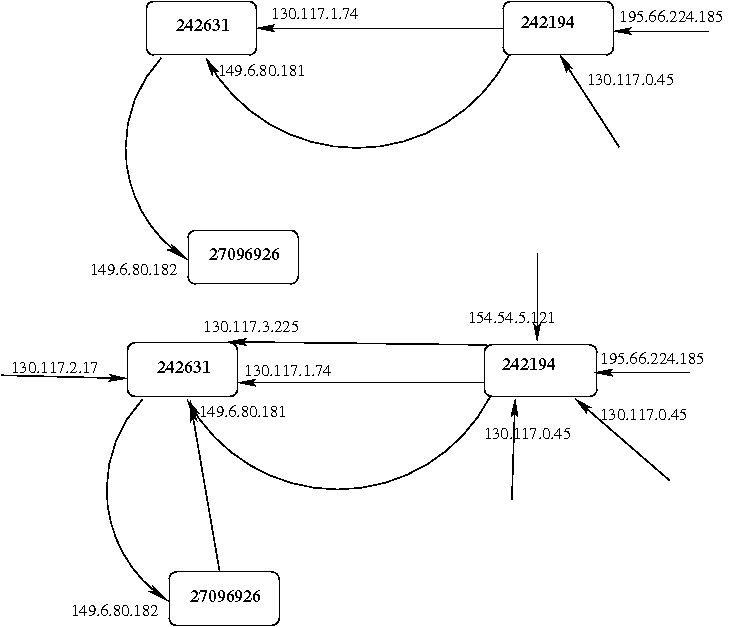
However, we find frequent instances of loops involving these routers,
for example traces of the form:
snip.. 130.117.1.74:N242631:174
149.6.80.182:N27096926:174
149.6.80.181:N242631:174 149.6.80.182:N27096926:174
..snip
The loop traces are the only instances where 149.6.80.181 and
149.6.80.182 appear in the same trace. These interfaces are seen as
successive hops in this trace.
Are loop traces removed completely? Or are the non-loop portions
retained?
![[CAIDA - Cooperative Association for Internet Data Analysis logo]](/images/caida_globe_faded.png)